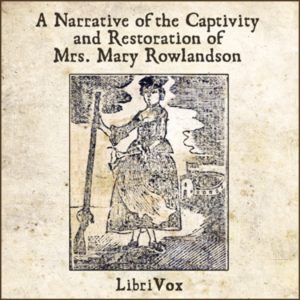Introduction to Mary Rowlandson by Svetlana Antropova
Mary Rowlandson (1637-1711)
by Svetlana Antropova
Mary Rowlandson, was born Mary White in 1637 in the Somerset County of Northwestern England. Her parents brought her to America when she was still a child. After Mary’s family arrived to America they first settled in Salem and later moved to the frontier town of Lancaster in the Massachusetts Bay Colony. There, in 1656 Mary met and married the Harvard-educated Puritan minister Joseph Rowlandson. For the next 20 years Mary was leading the life of a regular puritan wife, taking care of her home and children.

On February 10th 1676 while Mary’s husband was in Boston seeking military reinforcement for their settlement, Lancaster was attacked by Narraganset Indians. They killed seventeen settlers, and took twenty-four settlers hostage including Mary Rowlandson and her three children. One of Mary’s children, six year old Sarah, was mortally wounded during the attack and died a week later. Narraganset Indians kept Mary Rowlandson their prisoner for three months. During this time she was treated very badly, and only because of her knitting and sewing skills she earned a little better treatment then other captives. In May of 1676 Rowlandson’s husband was able to ransom her for twenty pounds. Soon after that, Mary and her husband got back their two surviving children. Mary’s husband, Joseph Rowlandson died in 1678. In 1679 Mary Rowlandson got married for a second time, to a Captain Samuel Talcott. Captain Talcott died in 1691, and for the rest of her life Mary lived as a widow. She passed away in 1711 at the age of seventy-three.
After the death of her first husband in 1678, Rowlandson wrote the short book, A Narrative of the Captivity and Restoration of Mrs. Mary Rowlandson. It was published in Cambridge, Massachusetts in 1682. This book became a bestseller and was the first English language narrative published by a woman in North America. Since then Mary Rowlandson is considered a pioneer of a new literary and historical genre, a captivity narrative.
In her story Mary vividly describes slaughter of her neighbors and family members, and death of her six-year-old child. She recounts her life among Native Americans whom she mostly calls “savages”, “hell-hounds” and “barbarous creatures” as a sorrowful journey during which Mary had to accommodate herself to the Native American culture, eat bear meat, and to experience hardship and cruelty. A stolen Bible that Mary received from one of the Indians was her only comfort in that difficult time. Even though Mary Rowlandson writes a lot about unspeakable cruelty that she had witnessed in her captivity, she by her own admission was never tortured or raped. Her Indian master promised to sell her back to her husband; she is being fed and paid for her sawing with food and other goods.
In her narrative Mary Rowlandson references scripture more than eighty times. Already in the beginning, describing the brutal attack on her village she quotes the Bible: “And I only am escaped along to tell the News” (Job 1.15). Puritans lived in a state of constant spiritual anxiety, always looking for signs of God’s anger or grace. They believed that human beings were depraved sinners and that only incontestable faith in God’s sovereignty was the key to salvation. That’s why during her captivity Mary Rowlandson has never questioned anything that happened to her, believing that her destiny is solely in God’s hands. She didn’t try to escape, and took everything that was happening to her with truly Puritan humility. Her initial survival as well as her final rescue Mary sees as a sign of God’s grace and salvation. She wrote her narrative as a gesture of eternal gratitude to God and as a spiritual guidance for the Puritan community.
Questions:
- Is Mary Rowlandson a good Christian?
- Do you think that Mary Rowlandson exaggerated her experience in captivity or do you believe that everything she wrote is true?
- Do you believe that Mary’s initial survival, capture and further rescue was a sign of God’s grace, or just a coincidence?
Text included with the permission of the author.
Image: Public Domain

